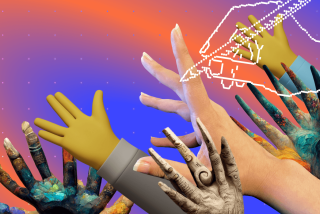Want to Change Your Image? Software Tool Lets You Goo for It
- Share via
Kai Krause is a familiar face at computer industry events, where he has been known to dazzle the crowd with the impressive software tools he creates for professional graphic artists.
Krause, co-founder of Carpinteria, Calif.-based MetaTools (formerly HSC Software), is best known as the developer of Kai’s Power Tools, a collection of programs that work with image-editing applications, such as Abobe Photoshop, to create special effects. Krause’s programs are used widely by artists for magazines, TV networks and newspapers.
Krause’s tools, in the hands of a talented graphic artist, can create the most bizarre and interesting shapes and textures. He, perhaps more than any other individual, has helped turn ordinary Macintoshes and PCs running Windows 95 into very sophisticated graphic workstations. Yet, as impressed as I am with his work, I haven’t written about it because his programs were not designed for a mass audience.
Until now.
His newest program is arguably more impressive than his high-end tools; however, Kai’s Power Goo is more of a toy than a tool. My wife, Patti, describes it as “Silly Putty for the computer.” The program sells for $49 and runs on CD-ROM-equipped Macintosh and Windows 95-powered machines with 8 or more megabytes of memory.
Power Goo is an image manipulation and distortion program that anyone can use to turn a plain scanned photograph into something weird, wacky and, in most cases, fun to look at.
You can use your mouse to enhance--or grossly distort--a smile. Eyes can be made larger or smaller or stretched into strange shapes. Your rather ordinary facial expressions can be “gooed” so you look like Jim Carrey doing one of his facial contortions. A smirk can be transformed into a big smile. You can grow, reshape or remove hair, change the shape of a nose or distort the look of a forehead or any other body part. You can even animate the images to create a little movie that shows a gradual transformation from the original image to the distorted one. Of course, it’s not just for manipulating faces. The CD-ROM comes with clip art images to play with that include cars, flags and animals.
My family and I had the most fun manipulating pictures of ourselves. Power Goo imports most standard file formats, including those used by scanners and digital cameras.
The program is amazingly easy to use. You import a graphic image or select one from the CD and use your mouse to manipulate and reshape any portion of the image. If you click on a person’s lips, for example, you can reshape them into a smile or a frown without necessarily changing other parts of the face. I now know what I would look like without hair, and I have even given myself a nose job and face lift. It reminds me of the mirrors at carnivals that can make you look fatter or thinner, though Kai’s Power Goo gives you far more control.
In my first couple of hours with the program, I used Goo mainly as a toy. But after a while, I discovered that it’s also a tool. You can do more than just create wacky images. It can also be used to make subtle enhancements to a picture. My son, William, has a lovely smile, but in one of his pictures he looks rather serious. I clicked on the corner of his lips and grossly distorted the image into a very big and unnatural looking smile. But then, using the program’s adjustment tool, I was able to change the image until it looked most natural. The whole process took less than a minute.
Talented graphic artists have long been able to do these things with Photoshop and other high-end imaging programs, but those have always been way beyond my skill level.
Krause and his team spent two years developing a set of high-end graphics tools, code-named Amazon. Amazon was never intended to become a product.
“It’s like Ferrari’s or Mercedes’ racing team that develops cars that can go as fast as possible whether or not they’re immediately applicable in a production vehicle,” Krause said. “We divorced ourselves from the immediacy and requirements of a product and just shot for the best. Afterward, we looked at what we had and reined it back in. Goo was a byproduct of that research.”
The program has a feature called Fusion that lets you combine bits and pieces from two sources. Ever wonder what Aunt Emma’s face would look like with Uncle Henry’s eyes? You can put pictures of both faces on the screen and pick and choose features.
Once you’ve created a “goo” image, you can click on a movie camera to see it animated. You don’t really have to worry about creating individual frames, as you typically would with computer animation. The process of distorting the image automatically creates a series of frames that can be played back.
The amazing thing about this program is that it runs in real time on a regular PC or Mac. With real-time image manipulation, the user can see the changes immediately instead of having to wait for the computer to draw them.
MetaTools can be reached at (800) 972-4025 or at its Web site, https://www.metatools.com
Lawrence J. Magid can be reached by e-mail at magid@latimes.com. His World Wide Web page is at https://www.larrysworld.com





